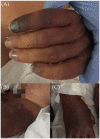The Great pretender: the first case of septic shock due to Capnocytophaga canimorsus in Sardinia. A Case report and review of the literature
- PMID: 36451937
- PMCID: PMC9703562
- DOI: 10.1177/22799036221133234
The Great pretender: the first case of septic shock due to Capnocytophaga canimorsus in Sardinia. A Case report and review of the literature
Abstract
Capnocytophaga canimorsus (C. canimorsus) is an emerging pathogen in critical care. C. canimorsus is a Gram-negative bacillus, commonly isolated as a commensal microorganism of the oral flora of healthy dogs and cats. A 63-year-old woman came to the emergency department with fever, chills, and malaise 2 days after a minor dog bite. After admission to the medicine ward, she developed respiratory failure and livedo reticularis. In the intensive care unit (ICU), she presented full-blown septic shock with thrombocytopenia, coagulopathy, severe acute kidney injury, and liver injury. We describe the first case of septic shock with Multiple Organ Dysfunction Syndrome related to Capnocytophaga canimorsus infection in Sardinia and its treatment in a tertiary hospital ICU. We also review recent literature on the relevance of C. canimorsus in human disease and critical illness.
Keywords: Capnocytophaga; Zoonosis; acute kidney injury; case report; ischemia; renal replacement therapy; septic shock.
© The Author(s) 2022.
Conflict of interest statement
The author(s) declared no potential conflicts of interest with respect to the research, authorship, and/or publication of this article.
Figures




Similar articles
-
Routine use of 16S rRNA PCR and subsequent sequencing from blood samples in septic shock: about two case reports of Capnocytophaga canimorsus infection in immunocompetent patients.BMC Infect Dis. 2022 Apr 9;22(1):355. doi: 10.1186/s12879-022-07328-z. BMC Infect Dis. 2022. PMID: 35397547 Free PMC article.
-
Rapid diagnosis of Capnocytophaga canimorsus septic shock in an immunocompetent individual using real-time Nanopore sequencing: a case report.BMC Infect Dis. 2019 Jul 24;19(1):660. doi: 10.1186/s12879-019-4173-2. BMC Infect Dis. 2019. PMID: 31340776 Free PMC article.
-
Bilateral acute renal cortical necrosis after a dog bite: case report.BMC Infect Dis. 2021 Feb 27;21(1):231. doi: 10.1186/s12879-021-05901-6. BMC Infect Dis. 2021. PMID: 33639872 Free PMC article.
-
[A fatal septic shock due to Capnocytophaga canimorsus and review of literature].Rev Med Interne. 2018 Oct;39(10):820-823. doi: 10.1016/j.revmed.2018.03.384. Epub 2018 Apr 26. Rev Med Interne. 2018. PMID: 29706238 Review. French.
-
Capnocytophaga canimorsus blebitis: case report and review of literature.BMC Ophthalmol. 2021 Jan 26;21(1):59. doi: 10.1186/s12886-021-01823-8. BMC Ophthalmol. 2021. PMID: 33499831 Free PMC article. Review.
Cited by
-
Capnocytophaga canimorsus from Dog Saliva Exposure Causing Severe Sepsis in a Healthy Adult: A Case Report.Am J Case Rep. 2025 Apr 25;26:e946691. doi: 10.12659/AJCR.946691. Am J Case Rep. 2025. PMID: 40279321 Free PMC article.
-
Furry, Fomite, and Facultative Anaerobe: A Unique Case of Capnocytophaga canimorsus.Cureus. 2023 Oct 26;15(10):e47747. doi: 10.7759/cureus.47747. eCollection 2023 Oct. Cureus. 2023. PMID: 38021979 Free PMC article.
References
-
- Bobo RA, Newton EJ. A previously undescribed gram-negative bacillus causing septicemia and meningitis. Am J Clin Pathol 1976; 65: 564–569. - PubMed
-
- Butler T, Weaver RE, Ramani TK, et al. Unidentified gram-negative rod infection. A new disease of man. Ann Intern Med 1977; 86(1): 1–5. - PubMed
-
- Dilegge SK, Edgcomb VP, Leadbetter ER. Presence of the oral bacterium Capnocytophaga canimorsus in the tooth plaque of canines. Vet Microbiol 2011; 149: 437–445. - PubMed
LinkOut - more resources
Full Text Sources
Miscellaneous
